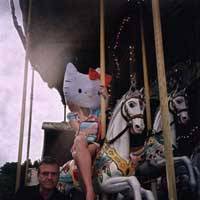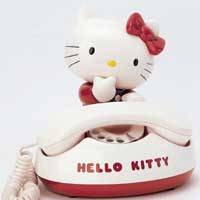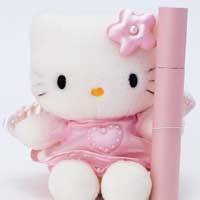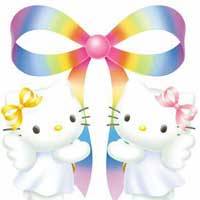At 10 a.m. last Saturday, the moment the doors of the Mitsukoshi department store in Tokyo's Nihonbashi district were opened, a small scrum of people rushed in, headed straight to the escalators and then up to the fifth floor.
There they stood in line for two full hours. Then, at noon, a woman with long, reddish-brown-dyed hair and wearing a leopard-print cap, a dragon-emblazoned black bomber jacket and matching black pants, sauntered incongruously into the pastel-colored Sanrio Co. store.
That woman was Yuko Yamaguchi, a designer at Sanrio who is almost single-handedly responsible for turning Japan's favorite feline mascot character, Hello Kitty, into a household name the world over.
There to sign autographs in the build-up to Hello Kitty's 30th birthday on Nov. 1, Yamaguchi sat down at a black table, took out her black pen -- and started drawing a picture of Hello Kitty on a Hello Kitty soft toy handed to her for the first of the day's limited number of 40 signings.
The woman who handed her toy to the designer was a mother accompanying a schoolboy. Yamaguchi addressed it -- as requested -- "To Yuka-chan." It was the mother, not the boy, who wanted her autograph.
In fact, except for a few schoolgirls, almost all those waiting in line were women in their 30s or 40s, or even older. Most asked Yamaguchi to write their own names, not their children's or grandchildren's.
Of all the department-store chains, Mitsukoshi is known for its more mature -- and affluent -- clientele. But with Hello Kitty now set to enter her fourth decade, an ever-growing portion of her fans today are adults like those seen at the store. And it's thanks to their spending power whenever they see something they want -- whether it's bags, stationery, chairs or soft toys -- that in fiscal 2003 Tokyo-based Sanrio grossed a mighty 103.9 billion yen in revenue.
(Although the character goods manufacturer/distributor would not reveal the exact percentage of its total sales directly linked to Hello Kitty, it did state that Hello Kitty merchandise constantly accounts for nearly 40 percent of takings at its 1,470 retail outlets in Japan -- and an even higher percentage of its revenues from licensing deals to allow motifs to be used on other makers' products. In addition, Hello Kitty pretty much dominates Sanrio's earnings from overseas.)
"The fans of Kitty, when I first started drawing her in 1980, were around 10 years old," Yamaguchi said before the autograph session. "Today, the average age of core Hello Kitty fans, I think, is about 34."
A look into the character's history provides a clue on how a feline with such a no-frills design -- three dots (for eyes and a nose), six whiskers, a ribbon and no mouth -- has turned into an international icon.
It surely wasn't a smooth rise to stardom. When Yamaguchi became Hello Kitty's third designer in 1980, the cat's popularity was waning after its initial boom in the mid-1970s. Though still among the top-selling characters in Japan, Hello Kitty was no longer the cat's whiskers.
Also, unlike most other leading merchandise characters such as Doraemon, Micky Mouse, Pokemon and Sailor Moon, Hello Kitty has no roots in cartoon or animation. In the case of those other characters, merchandise is often sold using a marketing technique called "media mix" -- meaning that consumers are exposed to the characters via games, movies, TV and videos before related products go on sale.
Sanrio, in contrast, has traditionally relied on "word of mouth" advertising, giving all the information about its products only at its retail outlets. At Sanrio, whose core business is creating characters in order to sell related goods, any character that sells well for more than a year is considered a hit, and most of its back-catalog of nearly 450 characters have long disappeared into obscurity. Its colorful Goropikadon range of "thundercloud" characters, for example, sold "explosively" in the early 1980s, as one Sanrio official put it, "only to drop out of view a couple of years later."
So back in 1980, when Hello Kitty was 6 years old, she was already considered a success just for having survived in the market. By then, though, girls were getting tired of her, because there were few variations in her clothes, poses or colors.
Desperate for ideas to revamp the feline's image, Yamaguchi took to the streets. She stormed into Sanrio outlets across the nation, signing autographs at storefronts, uninvited. At first, store managers shunned her, worrying she would get in the way of their sales activities.
"I was allowed to hold sessions only outside, so when it rained, I had to carry an umbrella myself," she recalled. "And there were those customers who said they didn't need my autographs. I was just like one of those people giving out packs of tissues on the streets."
But Yamaguchi wasn't just out there for the kudos of signing her name -- she was actually busy gathering intelligence, too, sniffing out what Hello Kitty fans liked or didn't like about the character.
Into the black to synchronize with social trends
The results of the designer's research were soon evident in a series of Hello Kitty makeovers, though she said she often had to battle fixed thinking within her own company to ring the changes. For example, in 1986 when she created a new Kitty variation featuring only her face, some senior Sanrio officials were enraged that she had "beheaded" the character.
Then in 1987, when black-and-white fashions were all the rage, she created a new line of Hello Kitty products in which black featured prominently. For Hello Kitty, that was a major turning point, as it was the first time the character started to synchronize with social trends -- and the first time Sanrio broadened its Hello Kitty target buyers from elementary-school girls to teenagers and even to adults.
The inspiration for this, Yamaguchi said, came from a letter she received from a high-school girl, who said her friends mocked her for being "childish" because she liked Hello Kitty stuff. The girl wanted her to create products that even people her age could carry around.
Similarly, it was an encounter with another fan that gave Yamaguchi the idea of launching "area-specific" novelties, through which Hello Kitty has been morphed into everything from peaches to an aji fish (cut-open and dried saurel) and a shiny black onsen tamago (hot-spring-boiled egg).
All that started when, around 10 years ago, one of the then burgeoning ranks of kogyaru high-school gals with long brown hair and "loose socks" came to see Yamaguchi at a Sanrio event in Shibuya and asked if Kitty could be turned into a bee.
"At first, I was like, 'Huh?' " Yamaguchi recalled. "I asked her why, and she said, 'Isn't it kawaii (cute)?' I drew a bee Kitty just for a try, then I thought, 'Hmm . . . this might actually be cute.' "
Innovations like that, and the constant development of new product ideas, have ensured that Sanrio's feline star has continued to shine brightly in the nation's highly competitive character-goods industry: As a moneymaker, Hello Kitty was ranked second only to Walt Disney's Winnie the Pooh in 2003, according to Tokyo-based character-business consulting firm Character Databank, Ltd.
Sanrio's ceaseless pursuit of cuteness has also sparked fascination all over the world, so much so that even celebrities like Mariah Carey, Christina Aguilera and Britney Spears have reportedly been seen toting Hello Kitty paraphernalia. However, interest in the character, especially among adults outside of Japan, may also be tinged with a sense of playful satire.
New York Times journalist Ken Belson, who coauthored a book on Hello Kitty with Brian Bremner, BusinessWeek's Asia economics editor, said he regarded Hello Kitty as a "joke" before learning that Sanrio was a serious and successful business enterprise. The translated version of the book, which delves into the history of Japan's "cuteness culture," was published by Toyo Keizai Inc. in June.
"There seems to be a lack of irony at Sanrio," Belson said over the phone from New York. "I don't want to sound unkind, but they don't seem to have a sense of humor about Hello Kitty. They are really serious about it, because it's their business. . . . But I think that what has happened is, a lot of people outside Sanrio see her as kind of a joke. They portray her with a sense of kitsch."
The cultural gap -- that Sanrio, with its teams of besuited marketing and sales pros, is seriously pitching something perceived by many people abroad as being mere kids' stuff -- was subtly evident at this summer's "Kitty Ex.," an exhibition of Hello Kitty-related artworks to commemorate the character's 30th anniversary. For the event, in which the company was peripherally involved, 64 prominent artists from Japan and abroad had been asked to create work inspired by Hello Kitty. In the name of art, some exhibitors got away with depictions that in any other context would likely have got them in legal hot water in an industry known for its stringent product-image control.
Visitors seemed taken aback by some objets d'art, which included American fashion designer Jeremy Scott's "Hello De Milo" featuring a replica of "Venus de Milo" with its head replaced by Hello Kitty, and French design duo M/M (PARIS)'s picture of three peeled apples stacked up, with a graphic image of a ribbon attached on top. Sanrio claims that Kitty's weight is that of three apples.
"I think children would be turned off," Eiko Yamashita, a 40-year-old visitor to the Osaka show, said. "If you take Kitty this far . . . I can only call it futuristic," she added, observing a Hello Kitty UFO at her foot.
Still, Yo Kato of Digital Hollywood Entertainment Corp., who planned "Kitty Ex.," was positive that the event helped boost recognition of the character and gave it a new lease of life.
"Japanese artists come from [a culture] in which Kitty has always been considered cute," Kato said. "The works of non-Japanese artists, on the other hand, tend to be un-cute, and sort of 'cool' and avant-garde because they learned about Kitty as adults."
Nonetheless, Kashiwa Sato, an art director who came up with the "Kitty Ex." title and logo, said that he feels Kitty has an "indestructible" quality about her. "No matter how much you beat up Kitty, she retains a presence," he said.
The void she represents -- reflected in the lack of a Hello Kitty plot or story line -- might be one reason why she can withstand so many off-the-wall, even satirical, manipulations.
While there is obviously some truth in the criticism that the allure of Hello Kitty -- and the cuteness she promotes -- is driven by consumerism, it has a positive side as well, observed Nobuyoshi Kurita, professor of sociology at Musashi University in Tokyo.
"The culture in Japan of taking delight in cuteness has dimensions that go far beyond infantilism or immaturity," he said, adding that characters from traditional fables such as "Momotaro" have long soothed people's minds.
"When people call character goods 'kawaii,' they are not just admiring the products, but they are also releasing a 'signal' through which they are trying to connect with others," Kurita argued.
"Kawaii is a magic word, which can lighten up the air," he said.
But can such intangible feelings transcend national boundaries along with the product? Kurita is betting they can.
"The culture of a family watching TV together in a living room never existed in Japan until TV sets were imported from America," he said.
"The culture of people projecting themselves into characters, which is unique to Japan, might be ephemeral, but it is certainly there -- and it's taking root in mature economies like America's.
"Soon, adults will get drawn into this culture, although I don't know if it will be Hello Kitty or some other character that will play that role."


























With your current subscription plan you can comment on stories. However, before writing your first comment, please create a display name in the Profile section of your subscriber account page.